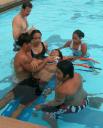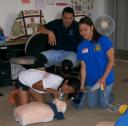Kaʻū Rural Health Celebrates Ten Years of Service

Jessie Marques (second from left) poses with the Emergency Response Academy in front of an Emergency Air Ambulance that visited Kaʻū.
The Kaʻū Rural Health Community Association, Inc. invites the public to its annual meeting celebrating its tenth anniversary on Friday, Nov. 9 at the PÄhala Community Center from 5 to 7 p.m. The meeting is titled Look to the Source of Kaʻū and will focus on the past, present and future of Kaʻū’s children, family and community. Elections will be held for new board members and refreshments will be served. Membership to the association is just $15 a year per household and allows members to run for office, a vote during the meeting and access to the association’s many resources.
KRHCAI has the distinction of being the first designated rural health community association in the nation, said Jessie Marques, who has been its executive director since is inception.
Marques, also the president of both the State Rural Health Association, and HawaiÊ»i Island Rural Health Association, has been plugging away, along with her board members to achieve their mission statement: “To Do Whatever it takes for a Healthy Kaʻū Community.â€
The headquarters is in the Kaʻū Resource & Distance Learning Center, a plantation-style building on Puahala St. in PÄhala. The center features a computer lab with internet access, a video conferencing unit, a kitchen for healthy eating classes, a lending library, fax machine and copier and a separate meeting space in the backyard. The center provides health, education, research opportunities, distance learning connectivity, job readiness and employment training programs.
The Association is partnering with the Kaʻū Hospital to provide Certified Nurses Aid training, with an “upward mobility program†to become Licensed Practical Nurses, said Marques. Using video teleconferencing, the center will become the classroom setting, with the hospital serving as the clinical setting.
“Our community is really long-term,†she said, referring to the elderly population. “We have a real need for homecare. Care-giving in the home setting is a very sensitive area. It is good to have someone from your own community,†said Marques.
The Association also helps to put on health fairs for the hospital and brings students to the hospital to introduce them to careers in health-related fields.
Using the video-teleconferencing program, the center is a conduit for the Ke Ānuenue Area Health Education Center, based in Hilo. Twice a month, Ke Ānuenue broadcasts learning sessions focused on diabetes, with a variety of other topics such as food safety or breast cancer, during the rest of the month. People interested in other topics can see the schedule at www.keanuenue.org and need to make a request at the center.
School-age students who are serious about learning and getting involved in their communities come to the center after school to take advantage of Marques’ many educational projects. Recently, KRHCAI joined the Hui’ana Internship Program, giving students an opportunity to earn school credits while learning about what it is like to run a non-profit and exposing them to the careers in the health and human service fields. Through the association, students enrolled in the Emergency Response Academy this summer, learning what it is like to be a real firefighter, taking part in drills, going through the firefighter’s coursework, as well as learning CPR, First-Aid and taking lifeguarding classes. Marques is looking for other employers to serve as internships sites for the Huiʻana program.






Young members of the Emergency Response Academy organized by the Kaʻū Rural Health Community Association practice being lifeguards and firefighters and learn how to do CPR and First Aid.
Using the polycom unit, students network with other schools during the holidays teaching each other healthy eating recipes, with chef and PÄhala resident Cy Lopez coming into teach food safety. At the center, students can also use NovaNET, to take Department of Education classes at their own pace or use video conferencing to take classes at a college.
Students will learn how to make videos in the near future with NÄ Leo’s “Bruddah Skibbs†donating his time to teach a multi-media class. The video class was the brainchild of the students. Marques, whom everyone affectionately refers to as Auntie Jessie, encourages the students to come up with their own ides of projects they want to do or things they want to learn about. “When the children are here and talking and visiting different places they get ideas about things they want to do and they ask about it,†she said.
KRHCAI also gives the students opportunities to build up their community service portfolio. “I ask them, Ê»Do you understand what is going on in your community?’†said Marques. She said she tries to teach the students ownership and “what are we doing in our community and how it impacts you.â€
For adult students the center is also looking to be a remote site for Hawaiʻi community college, starting with the Hawaiʻi Competency-Based High School Diploma Program and the General Educational Development Program. Marques is looking for local instructors to help teach the programs instead of bringing out “We would like to have all of the things that the college offers here. We need community input.†Marques is also canvassing the neighborhoods, especially the Filipino community, to see how many people in Kaʻū need citizenship and to bring those classes to them.
“Partnership with the hospital and Hawaiʻi Community College for adults will open up a whole new avenue of using technology in our community and increase awareness of computers and internet,†said Marques.
People looking for work can also use the computers at the center to access jobline, an employment networking resource. In the past, the center also put on a job fair
The Kaʻū Rural Health Community Association’s roots are tied to the Kaʻū Hospital. In 1997, when the Kaʻū Hospital Emergency Room was threatened with closure, Marques, a retired nurse, and a group of volunteers worked towards getting the hospital designated as a critical access hospital, the first of its kind in the state. “We had people signing petitions and letters and faxing it to legislature, until they asked us to please stop,†said Marques. Due to Kaʻū’s grassroots efforts, there are now seven critical access hospitals designations in Hawaiʻi.
After that success, Marques decided to take their efforts one step further and proposed to form a nonprofit to continue their work to keep Kaʻū healthy. “It takes more than everyone contributing piecemeal to having our voices heard,†said Marques. “250 people agreed.â€
Since its inception, the KRHCAI has also had a hand in forming the Drug Nuisance and Abatement Act, penned by state Rep. Bob Herkes, addressing the problem of Crystal Meth, said Marques. “Kaʻū set a milestone where this law impacted the whole state because of our diligence and our work able to contribute it to that…The issue came from members of the association…as a community we mobilized.†The association drew up a petition and had people sign to show their support of the issue.
KRHCAI, largely supported by grants, is continuing its vision for a healthy Kaʻū, but needs membership to show community support. Last year, the association had 125 members. For more information on the association and its programs, call 928-0101.